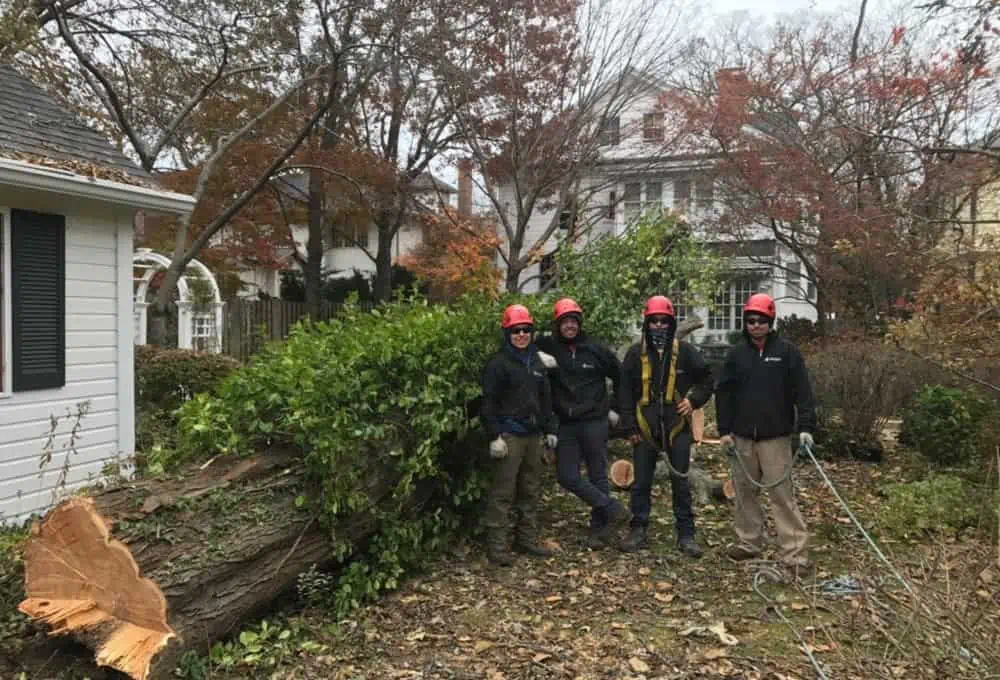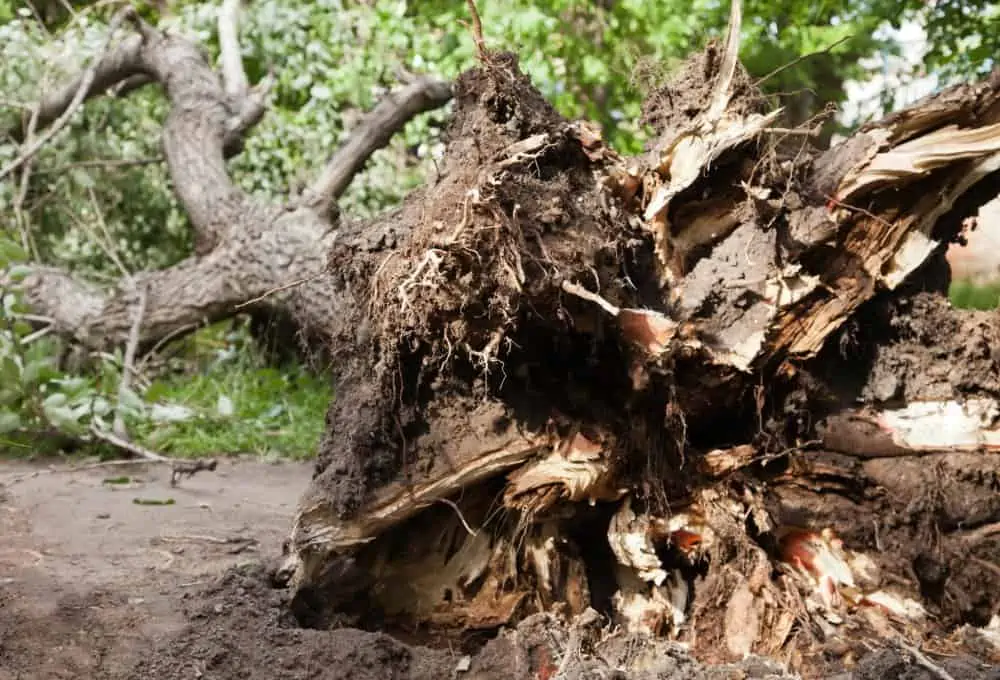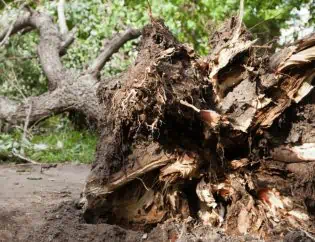
In the aftermath of a severe storm, the cleanup and removal of storm-damaged trees can be a challenging and overwhelming task. To assist property owners in this process, Progressive Tree Service, a trusted provider of storm damage cleanup services, has compiled eight essential tips for emergency tree cleanup. This comprehensive guide aims to equip homeowners, commercial property owners, and municipalities with the knowledge and tools necessary to effectively restore their outdoor spaces. From assessing the extent of the damage to implementing preventive measures for future storms, these guidelines will ensure a safe and efficient cleanup process. By adhering to these expert recommendations, property owners can restore the beauty and functionality of their landscapes, promoting a sense of belonging within their communities.
Assess the Extent of the Damage
To effectively address storm-damaged trees, the first crucial step is to assess the extent of the damage. Assessing the damage is essential to determine the appropriate course of action and ensure the safety of the tree and surrounding areas. Safety measures should be taken into consideration when assessing storm-damaged trees. It is important to wear personal protective equipment such as gloves, goggles, and helmets to protect oneself from potential hazards.
When assessing the damage, it is important to carefully inspect the tree for any visible signs of damage, such as broken or hanging branches, split trunks, or uprooted roots. Branch removal may be necessary for safety reasons or to improve the overall stability of the tree. Limb pruning may also be required to remove damaged or diseased branches and promote healthy growth.
Tree stability is a critical factor to consider when assessing storm-damaged trees. If the tree is leaning or has a compromised root system, it may pose a risk of falling and causing further damage or injury. In such cases, it is recommended to seek professional assistance from certified arborists who have the expertise and specialized equipment to safely evaluate and stabilize or remove the tree.

Prioritize Safety Precautions
How can you prioritize safety precautions during emergency storm-damaged tree cleanup?
Note: Depending on the situation, it is generally safer to call an arborist with the proper equipment and extended experience to deal with this kind of emergency. Getting in the vicinity of a storm felled tree will expose you to hightened risks.
It is crucial to ensure the safety of yourself and others involved in the cleanup process. Here are some tips to help you prioritize safety precautions - make sure you perform them from a safe distance:
- Get everyone away from the tree: there might be hidden hazards such as electrical cables, or tensioned branches that might snap back at any time and hit back with tremendous force. If unsure, stay away from the area around the tree and call a professional tree service company.
- Use safety equipment: Wear appropriate safety gear, such as hard hats, gloves, and safety glasses, to protect yourself from potential hazards.
- Implement emergency response: Establish a clear emergency response plan and communicate it to all members of the cleanup crew. This will ensure a prompt and effective response in case of any accidents or injuries.
- Conduct tree inspection: Before starting the cleanup, thoroughly inspect the trees for any visible signs of damage or instability. This will help identify potential risks and prioritize their removal.
- Perform hazard assessment: Assess the surrounding area for any potential hazards, such as downed power lines or unstable structures. Address these hazards before proceeding with the cleanup.
- Practice risk management: Develop a systematic approach to manage risks during the cleanup process. This includes properly securing equipment, using safe cutting techniques, and ensuring proper supervision and communication among the crew.
Remove Hanging or Dangerous Branches
During emergency storm-damaged tree cleanup, it is essential to address the removal of hanging or dangerous branches to ensure the safety of the cleanup crew and surrounding area. Pruning techniques play a crucial role in this process, as they allow for the selective removal of damaged or unstable branches, promoting tree stability and reducing the risk of further damage or injury.
When dealing with hanging or dangerous branches, safety precautions must be taken into consideration. It is important to assess the stability of the tree before attempting any branch removal. If the tree is deemed unstable or the branches are too high to reach safely, it may be necessary to seek professional assistance to avoid potential accidents.
When removing hanging branches, it is advisable to start from the top and work your way down. This approach minimizes the risk of additional branches falling unexpectedly. Additionally, using proper pruning techniques, such as making clean cuts just outside the branch collar, helps promote the tree's healing process and prevents further damage.
In some cases, tree removal may be considered if the tree is severely damaged or poses a significant risk. Consulting with a certified arborist can provide valuable insight into the best course of action, ensuring the safety of the cleanup crew and preserving the integrity of the surrounding area.
Properly Prune Damaged Limbs
The proper pruning of damaged limbs is an essential step in ensuring the safety and structural integrity of the tree during emergency storm-damaged tree cleanup. When it comes to tree pruning techniques, there are a few key points to keep in mind:
- Limb removal: Carefully assess the extent of the damage and identify the limbs that need to be removed. It is important to remove any broken or hanging limbs that pose a risk to people or property.
- Tree branch trimming: Use proper pruning tools, such as pruning shears or loppers, to trim damaged branches. Make clean cuts just outside the branch collar, which is the swollen area where the branch attaches to the trunk.
In addition to these pruning techniques, there are some important tree maintenance tips to consider after a storm:
- Assess tree health: Look for signs of disease, decay, or insect infestation as you prune damaged limbs. Address any issues promptly to ensure the long-term health of the tree.
- Provide post-storm care: After pruning, apply a layer of mulch around the base of the tree to help retain moisture and protect the roots. Regularly water the tree, especially during dry spells, to promote recovery.
Evaluate the Stability of the Tree
Firstly, assess the stability of the tree to determine the extent of damage caused by the storm. Evaluating the tree's stability is crucial to ensure the safety of both people and property. Start by examining the trunk for any visible signs of damage, such as cracks, splits, or leaning. These indicators can suggest structural weakness and may require immediate attention.
Next, inspect the branches for any signs of damage or decay. Look for broken or hanging branches, as they can pose a serious hazard if they were to fall. Additionally, check for dead or dying branches, as they can weaken the overall stability of the tree.
If the tree shows signs of instability, it is important to prioritize tree safety by pruning or removing the damaged sections. Pruning can help to eliminate any hazardous branches, while removal may be necessary if the entire tree is compromised.
Consider Professional Services if Necessary
To ensure the safety of your property and surrounding areas, it is essential to consider professional tree removal services if the storm-damaged tree poses a significant risk. Hiring professionals for tree removal can provide you with the expertise and specialized equipment needed to safely and efficiently remove the damaged tree. Here are some key reasons why professional assistance is necessary:
- Emergency services: Professional tree removal companies offer 24/7 emergency services, ensuring that they can quickly respond to your needs and address any immediate risks posed by the storm-damaged tree.
- Damage assessment: Trained arborists can accurately assess the extent of the damage and determine the best course of action. They have the knowledge and experience to identify structural weaknesses and potential hazards that may not be apparent to an untrained eye.
- Safety precautions: Removing a storm-damaged tree can be a dangerous task, especially if it is near power lines or structures. Professional tree removal companies follow strict safety protocols and have the necessary equipment to handle the job safely, minimizing the risk of accidents or further property damage.
- Proper disposal: After removing the tree, professionals will handle the proper disposal of the debris, ensuring that it is done in an environmentally friendly manner.
Protect and Nurture the Remaining Trees
How can you effectively protect and nurture the remaining trees after a storm? Tree preservation is crucial in ensuring the health and longevity of the surviving trees. One important aspect of tree preservation is maintaining soil health. After a storm, the soil may become compacted or eroded, which can negatively impact the trees. To counteract this, it is essential to aerate the soil and add organic matter to improve its structure and nutrient content. Another important step is tree fertilization. Providing the necessary nutrients to the trees can help them recover from the stress caused by the storm and promote new growth. Additionally, proper tree watering is vital to support their recovery. Deep watering, focusing on the root zone, will help the trees establish a strong root system and withstand future storms. Lastly, tree mulching plays a significant role in protecting and nurturing the remaining trees. A layer of mulch around the base of the trees will conserve moisture, regulate soil temperature, and inhibit weed growth, all of which contribute to the overall health and resilience of the trees. By following these practices, you can ensure the protection and nurturing of the remaining trees, fostering a sense of belonging and connection to your outdoor space.
Follow Proper Disposal and Recycling Guidelines
Properly disposing and recycling storm-damaged trees requires adherence to specific guidelines. When it comes to handling the aftermath of a storm, it is important to follow recycling guidelines and disposal methods that prioritize sustainable practices and minimize the environmental impact. Here are some key points to consider:
- Recycling guidelines:
- Check with your local recycling center or waste management facility to find out if they accept storm-damaged trees for recycling.
- If recycling is available, follow the specific guidelines provided by the facility, such as removing branches or cutting the tree into manageable pieces.
- If recycling is not an option, consider alternative disposal methods, such as chipping the tree for mulch or using it for firewood.
- Composting is another eco-friendly option for disposing of smaller tree debris, such as leaves and twigs.
It is crucial to be aware of local regulations regarding tree disposal and recycling. Some areas may have specific requirements or restrictions on how storm-damaged trees should be handled. By following these guidelines and regulations, you can ensure that your tree cleanup efforts align with sustainable practices and contribute to a healthier environment.
Implement Preventive Measures for Future Storms
By implementing preventive measures for future storms, tree owners can minimize the risk of storm damage and ensure the long-term health and stability of their trees. One of the most important steps in storm damage prevention is emergency preparedness. This involves creating a plan that outlines how to protect trees during severe weather events. Tree owners should also prioritize regular tree maintenance, including pruning dead or weak branches, as this can significantly reduce the likelihood of storm damage.
Tree inspection is another crucial aspect of storm damage prevention. Regular inspections by certified arborists can identify potential issues such as diseased or structurally compromised trees that are more susceptible to storm damage. Additionally, conducting a comprehensive tree health assessment can help identify any underlying health issues that might make the trees more vulnerable to storms.
In addition to these measures, tree owners should also consider factors such as tree species and their susceptibility to storm damage. Certain species are more prone to uprooting or branch failure during storms, and it may be advisable to avoid planting such trees in areas with high wind exposure.
Implementing preventive measures for future storms is essential for maintaining the health and stability of trees. By focusing on emergency preparedness, regular tree maintenance, tree inspection, and tree health assessment, tree owners can minimize the risk of storm damage and ensure the longevity of their trees.

You must be logged in to post a comment.